Modular Construction: Material Selection, Techniques & Management
VerifiedAdded on 2023/03/23
|8
|1813
|55
Report
AI Summary
This report explores modular construction, focusing on its sustainability, safety, and health benefits. It discusses the use of recycled materials, sustainable energy practices, and reduced site activities. Modular construction, where building components are manufactured off-site, offers advantages like waste reduction, enhanced control, and a lower environmental impact. The report highlights the health and safety benefits of factory-based construction, including reduced accident risks and improved working conditions. It also addresses stakeholder management in the modular construction industry, emphasizing the roles of manufacturers and dealers. The conclusion emphasizes modular construction's potential to enhance project schedules, budgets, and quality while minimizing environmental effects. Desklib offers a wealth of resources, including past papers and solved assignments, to aid students in understanding modular construction and other civil engineering topics.
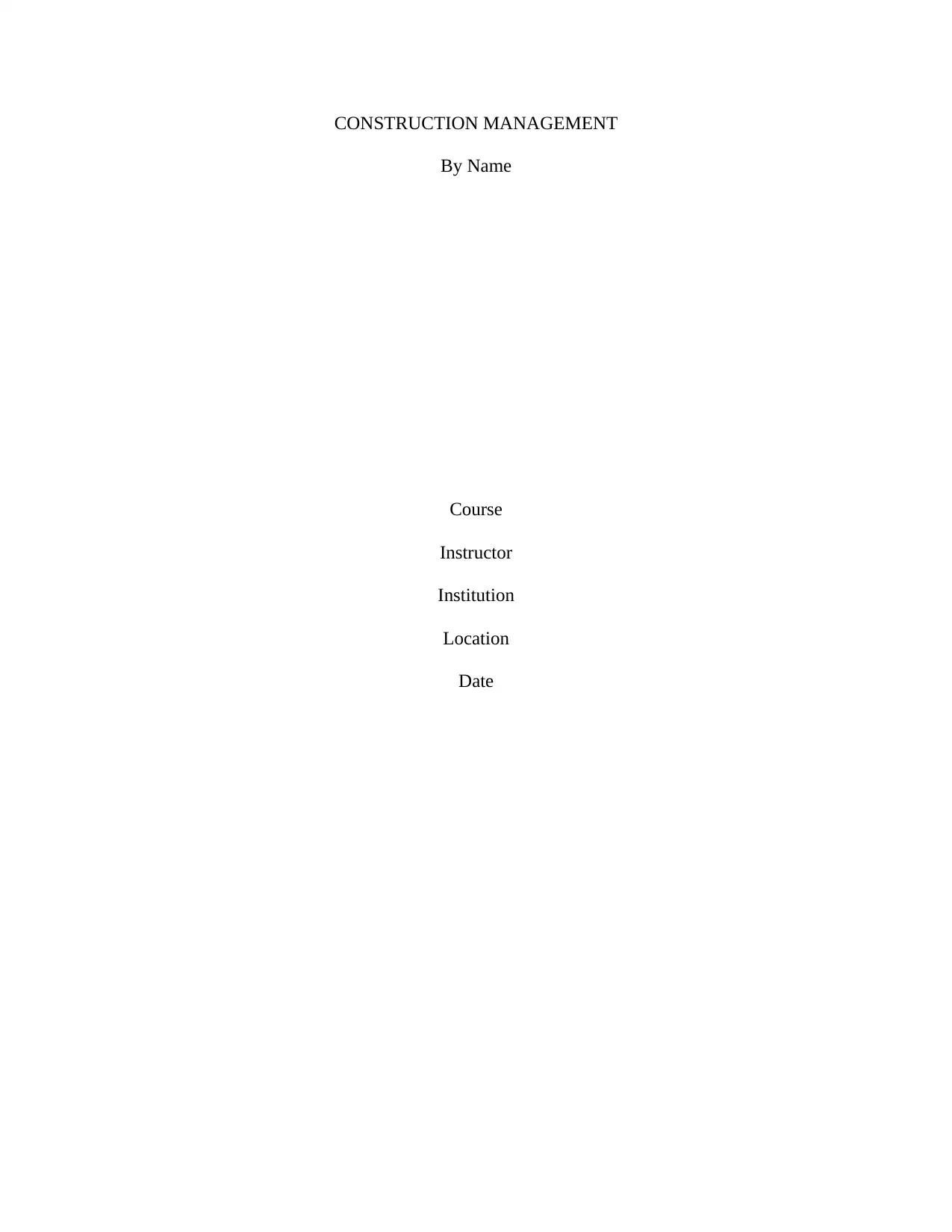
CONSTRUCTION MANAGEMENT
By Name
Course
Instructor
Institution
Location
Date
By Name
Course
Instructor
Institution
Location
Date
Paraphrase This Document
Need a fresh take? Get an instant paraphrase of this document with our AI Paraphraser

Executive Summary
Modular construction has gained momentum in the construction industry as well as a strong
market in the residential buildings alongside the educational as well as health buildings in which
the benefits of enhanced construction are attained. The paper addresses the sustainability as well
as the safety and health benefits of modular construction including discussion on such factors as
reuse and recycles sustainable energy as well as reduced site activities.
Introduction
Modular construction defines a form of construction that is done off the site where the
components of the building also known as the modules are manufactured within the settings of a
factory prior to transportation to the assembly for the purposes of assemblage. The modular units
can be used in the formation of complete rooms, separation of highly serviced units for example
lifts or toilets or even in the construction of parts of rooms (Baldea, Edgar, Stanley and Kiss,
2017). The gathering of the modular units forms a structure that is self-supporting in its own
right or for the case of tall buildings may be dependent upon the structural framework. Modular
construction is applied in numerous sectors including private housing, hotels, apartments as well
as mixed use development, social housing, buildings in the health sector, student residences as
well as educational sector, housing for the public sector as well as main worker accommodation
alongside sheltered housing.
Health and safety
Modules which are used as the main building blocks of modular construction are made offsite
with the use of specialist plant machinery in a regulated environment. The process results in
waste reduction as well as enhances control resulting in a low environment impact of the
Modular construction has gained momentum in the construction industry as well as a strong
market in the residential buildings alongside the educational as well as health buildings in which
the benefits of enhanced construction are attained. The paper addresses the sustainability as well
as the safety and health benefits of modular construction including discussion on such factors as
reuse and recycles sustainable energy as well as reduced site activities.
Introduction
Modular construction defines a form of construction that is done off the site where the
components of the building also known as the modules are manufactured within the settings of a
factory prior to transportation to the assembly for the purposes of assemblage. The modular units
can be used in the formation of complete rooms, separation of highly serviced units for example
lifts or toilets or even in the construction of parts of rooms (Baldea, Edgar, Stanley and Kiss,
2017). The gathering of the modular units forms a structure that is self-supporting in its own
right or for the case of tall buildings may be dependent upon the structural framework. Modular
construction is applied in numerous sectors including private housing, hotels, apartments as well
as mixed use development, social housing, buildings in the health sector, student residences as
well as educational sector, housing for the public sector as well as main worker accommodation
alongside sheltered housing.
Health and safety
Modules which are used as the main building blocks of modular construction are made offsite
with the use of specialist plant machinery in a regulated environment. The process results in
waste reduction as well as enhances control resulting in a low environment impact of the

construction process. Such modules are the delivered to the site when prefitted with such
services as doors, windows, heating, electrics as well as plumbing hence resulting in a reduction
in the onsite building program alongside acceleration of the overall process of construction
(Fifield, Lomas, Giridharan and Allinson, 2018). The lowered time of onsite building alongside
the indoor production environment combine together to result in a reduction of the risks of
accidents linked with construction sites. A report published by CIBSE journal made a conclusion
that the construction industry may reasonably anticipate a reduction in the levels of accidents
suppose more of a manufacturing mind set is adopted. Methods of factory construction tend to
pose fewer risks to the general public as well as workers in comparison with the inherent dangers
experienced in a construction site.
Modular construction is able to offer cleaner as well as safer working environment. The
conditions that are based on the factory of offsite allow safety requirements to be met more
easily and in a policed manner resulting in better quality, lowering of the defect levels as well as
enhanced procedures of quality control (Švajlenka, Kozlovská and Spišáková, 2017). This not
only results in a reduction in the trips, falls and slips especially as the height of work is lowered
but also a reduction in the number of activities taking place on site. The manual handling as well
as lifting of goods on the site is as well lowered since the movement of the materials is done
mechanically in a production unit that is intensively regulated.
Sustainability
Modular construction tends to be cheaper and less time consuming to construct in comparison
with the conventional methods of construction. Nevertheless, it as well brings along a raft of
benefits associated with sustainability too including such aspects as using less energy, recycled
materials as well as the constructed structures of modular buildings being recyclable.
services as doors, windows, heating, electrics as well as plumbing hence resulting in a reduction
in the onsite building program alongside acceleration of the overall process of construction
(Fifield, Lomas, Giridharan and Allinson, 2018). The lowered time of onsite building alongside
the indoor production environment combine together to result in a reduction of the risks of
accidents linked with construction sites. A report published by CIBSE journal made a conclusion
that the construction industry may reasonably anticipate a reduction in the levels of accidents
suppose more of a manufacturing mind set is adopted. Methods of factory construction tend to
pose fewer risks to the general public as well as workers in comparison with the inherent dangers
experienced in a construction site.
Modular construction is able to offer cleaner as well as safer working environment. The
conditions that are based on the factory of offsite allow safety requirements to be met more
easily and in a policed manner resulting in better quality, lowering of the defect levels as well as
enhanced procedures of quality control (Švajlenka, Kozlovská and Spišáková, 2017). This not
only results in a reduction in the trips, falls and slips especially as the height of work is lowered
but also a reduction in the number of activities taking place on site. The manual handling as well
as lifting of goods on the site is as well lowered since the movement of the materials is done
mechanically in a production unit that is intensively regulated.
Sustainability
Modular construction tends to be cheaper and less time consuming to construct in comparison
with the conventional methods of construction. Nevertheless, it as well brings along a raft of
benefits associated with sustainability too including such aspects as using less energy, recycled
materials as well as the constructed structures of modular buildings being recyclable.
⊘ This is a preview!⊘
Do you want full access?
Subscribe today to unlock all pages.

Trusted by 1+ million students worldwide
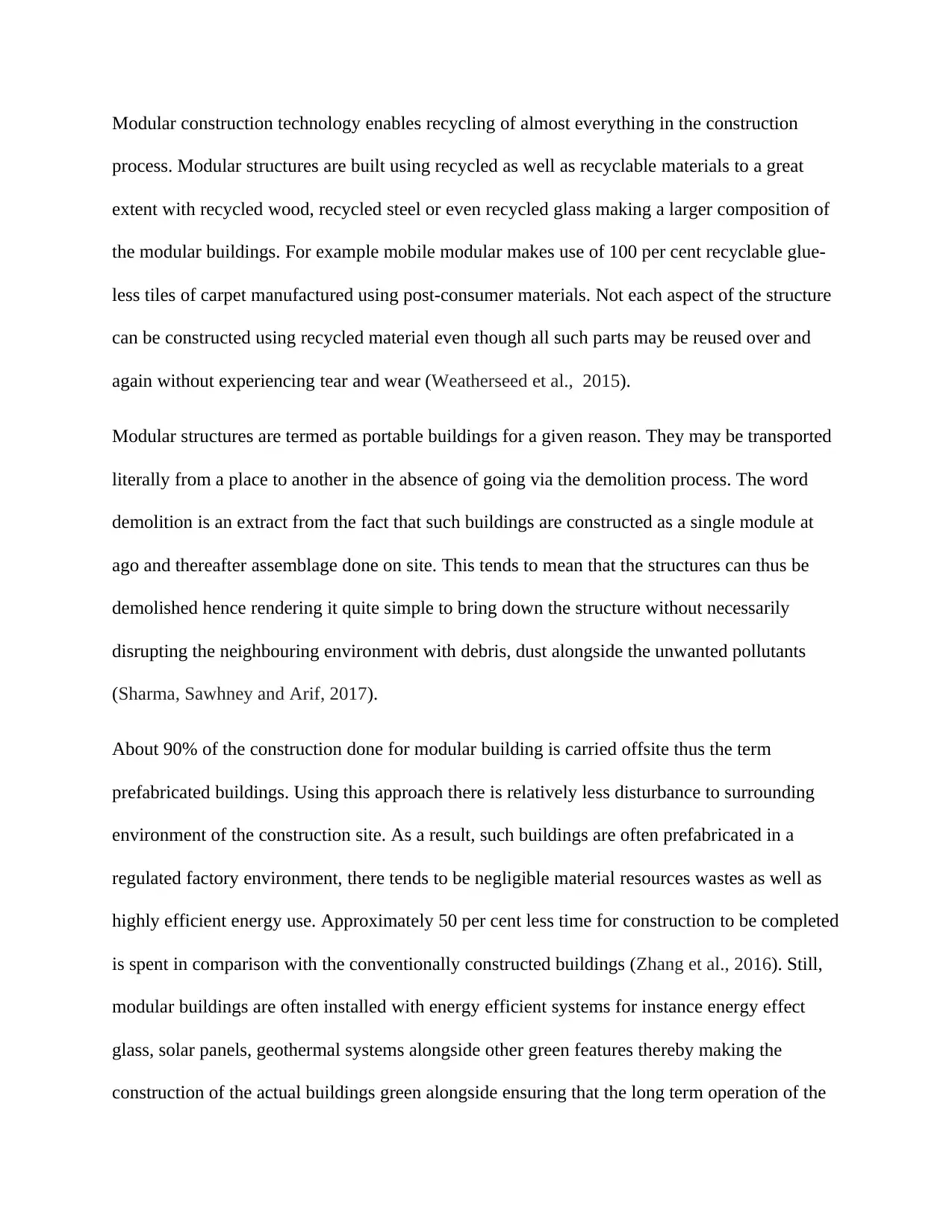
Modular construction technology enables recycling of almost everything in the construction
process. Modular structures are built using recycled as well as recyclable materials to a great
extent with recycled wood, recycled steel or even recycled glass making a larger composition of
the modular buildings. For example mobile modular makes use of 100 per cent recyclable glue-
less tiles of carpet manufactured using post-consumer materials. Not each aspect of the structure
can be constructed using recycled material even though all such parts may be reused over and
again without experiencing tear and wear (Weatherseed et al., 2015).
Modular structures are termed as portable buildings for a given reason. They may be transported
literally from a place to another in the absence of going via the demolition process. The word
demolition is an extract from the fact that such buildings are constructed as a single module at
ago and thereafter assemblage done on site. This tends to mean that the structures can thus be
demolished hence rendering it quite simple to bring down the structure without necessarily
disrupting the neighbouring environment with debris, dust alongside the unwanted pollutants
(Sharma, Sawhney and Arif, 2017).
About 90% of the construction done for modular building is carried offsite thus the term
prefabricated buildings. Using this approach there is relatively less disturbance to surrounding
environment of the construction site. As a result, such buildings are often prefabricated in a
regulated factory environment, there tends to be negligible material resources wastes as well as
highly efficient energy use. Approximately 50 per cent less time for construction to be completed
is spent in comparison with the conventionally constructed buildings (Zhang et al., 2016). Still,
modular buildings are often installed with energy efficient systems for instance energy effect
glass, solar panels, geothermal systems alongside other green features thereby making the
construction of the actual buildings green alongside ensuring that the long term operation of the
process. Modular structures are built using recycled as well as recyclable materials to a great
extent with recycled wood, recycled steel or even recycled glass making a larger composition of
the modular buildings. For example mobile modular makes use of 100 per cent recyclable glue-
less tiles of carpet manufactured using post-consumer materials. Not each aspect of the structure
can be constructed using recycled material even though all such parts may be reused over and
again without experiencing tear and wear (Weatherseed et al., 2015).
Modular structures are termed as portable buildings for a given reason. They may be transported
literally from a place to another in the absence of going via the demolition process. The word
demolition is an extract from the fact that such buildings are constructed as a single module at
ago and thereafter assemblage done on site. This tends to mean that the structures can thus be
demolished hence rendering it quite simple to bring down the structure without necessarily
disrupting the neighbouring environment with debris, dust alongside the unwanted pollutants
(Sharma, Sawhney and Arif, 2017).
About 90% of the construction done for modular building is carried offsite thus the term
prefabricated buildings. Using this approach there is relatively less disturbance to surrounding
environment of the construction site. As a result, such buildings are often prefabricated in a
regulated factory environment, there tends to be negligible material resources wastes as well as
highly efficient energy use. Approximately 50 per cent less time for construction to be completed
is spent in comparison with the conventionally constructed buildings (Zhang et al., 2016). Still,
modular buildings are often installed with energy efficient systems for instance energy effect
glass, solar panels, geothermal systems alongside other green features thereby making the
construction of the actual buildings green alongside ensuring that the long term operation of the
Paraphrase This Document
Need a fresh take? Get an instant paraphrase of this document with our AI Paraphraser
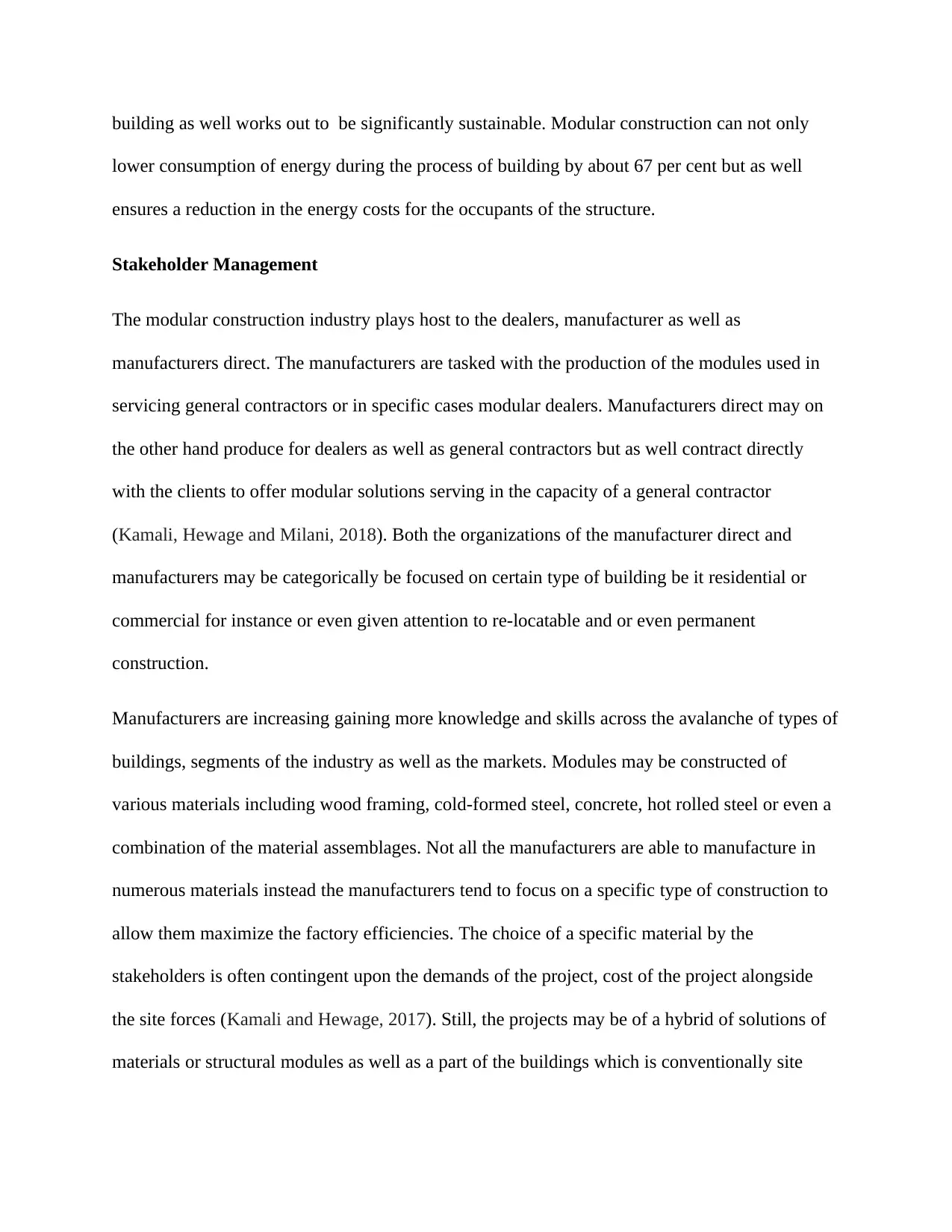
building as well works out to be significantly sustainable. Modular construction can not only
lower consumption of energy during the process of building by about 67 per cent but as well
ensures a reduction in the energy costs for the occupants of the structure.
Stakeholder Management
The modular construction industry plays host to the dealers, manufacturer as well as
manufacturers direct. The manufacturers are tasked with the production of the modules used in
servicing general contractors or in specific cases modular dealers. Manufacturers direct may on
the other hand produce for dealers as well as general contractors but as well contract directly
with the clients to offer modular solutions serving in the capacity of a general contractor
(Kamali, Hewage and Milani, 2018). Both the organizations of the manufacturer direct and
manufacturers may be categorically be focused on certain type of building be it residential or
commercial for instance or even given attention to re-locatable and or even permanent
construction.
Manufacturers are increasing gaining more knowledge and skills across the avalanche of types of
buildings, segments of the industry as well as the markets. Modules may be constructed of
various materials including wood framing, cold-formed steel, concrete, hot rolled steel or even a
combination of the material assemblages. Not all the manufacturers are able to manufacture in
numerous materials instead the manufacturers tend to focus on a specific type of construction to
allow them maximize the factory efficiencies. The choice of a specific material by the
stakeholders is often contingent upon the demands of the project, cost of the project alongside
the site forces (Kamali and Hewage, 2017). Still, the projects may be of a hybrid of solutions of
materials or structural modules as well as a part of the buildings which is conventionally site
lower consumption of energy during the process of building by about 67 per cent but as well
ensures a reduction in the energy costs for the occupants of the structure.
Stakeholder Management
The modular construction industry plays host to the dealers, manufacturer as well as
manufacturers direct. The manufacturers are tasked with the production of the modules used in
servicing general contractors or in specific cases modular dealers. Manufacturers direct may on
the other hand produce for dealers as well as general contractors but as well contract directly
with the clients to offer modular solutions serving in the capacity of a general contractor
(Kamali, Hewage and Milani, 2018). Both the organizations of the manufacturer direct and
manufacturers may be categorically be focused on certain type of building be it residential or
commercial for instance or even given attention to re-locatable and or even permanent
construction.
Manufacturers are increasing gaining more knowledge and skills across the avalanche of types of
buildings, segments of the industry as well as the markets. Modules may be constructed of
various materials including wood framing, cold-formed steel, concrete, hot rolled steel or even a
combination of the material assemblages. Not all the manufacturers are able to manufacture in
numerous materials instead the manufacturers tend to focus on a specific type of construction to
allow them maximize the factory efficiencies. The choice of a specific material by the
stakeholders is often contingent upon the demands of the project, cost of the project alongside
the site forces (Kamali and Hewage, 2017). Still, the projects may be of a hybrid of solutions of
materials or structural modules as well as a part of the buildings which is conventionally site

built as a result of the programmatic demands including large openings, spans alongside other
which are hard to pre-assemble within the factory.
Conclusion
Modular construction may service a number of buildings as well as construction types including
health care, education, office, hospitality, and housing among other constructions. Modular
construction is a building process of delivery just the same way it is an amalgamation of products
of a building (Goulding et al., 2015). When properly and sufficiently comprehended by
stakeholders combined with early project planning, it is best understood solution in regulation
the project schedules as well as budgets while enhancing the quality as well as s reduction in the
environmental effects. Modular construction is an efficient way in deployment aimed at
shortening building cycles, unique projects or even repetitious ones as well as with teams ready
to embrace the challenges alongside opportunities linked with its delivery.
which are hard to pre-assemble within the factory.
Conclusion
Modular construction may service a number of buildings as well as construction types including
health care, education, office, hospitality, and housing among other constructions. Modular
construction is a building process of delivery just the same way it is an amalgamation of products
of a building (Goulding et al., 2015). When properly and sufficiently comprehended by
stakeholders combined with early project planning, it is best understood solution in regulation
the project schedules as well as budgets while enhancing the quality as well as s reduction in the
environmental effects. Modular construction is an efficient way in deployment aimed at
shortening building cycles, unique projects or even repetitious ones as well as with teams ready
to embrace the challenges alongside opportunities linked with its delivery.
⊘ This is a preview!⊘
Do you want full access?
Subscribe today to unlock all pages.

Trusted by 1+ million students worldwide
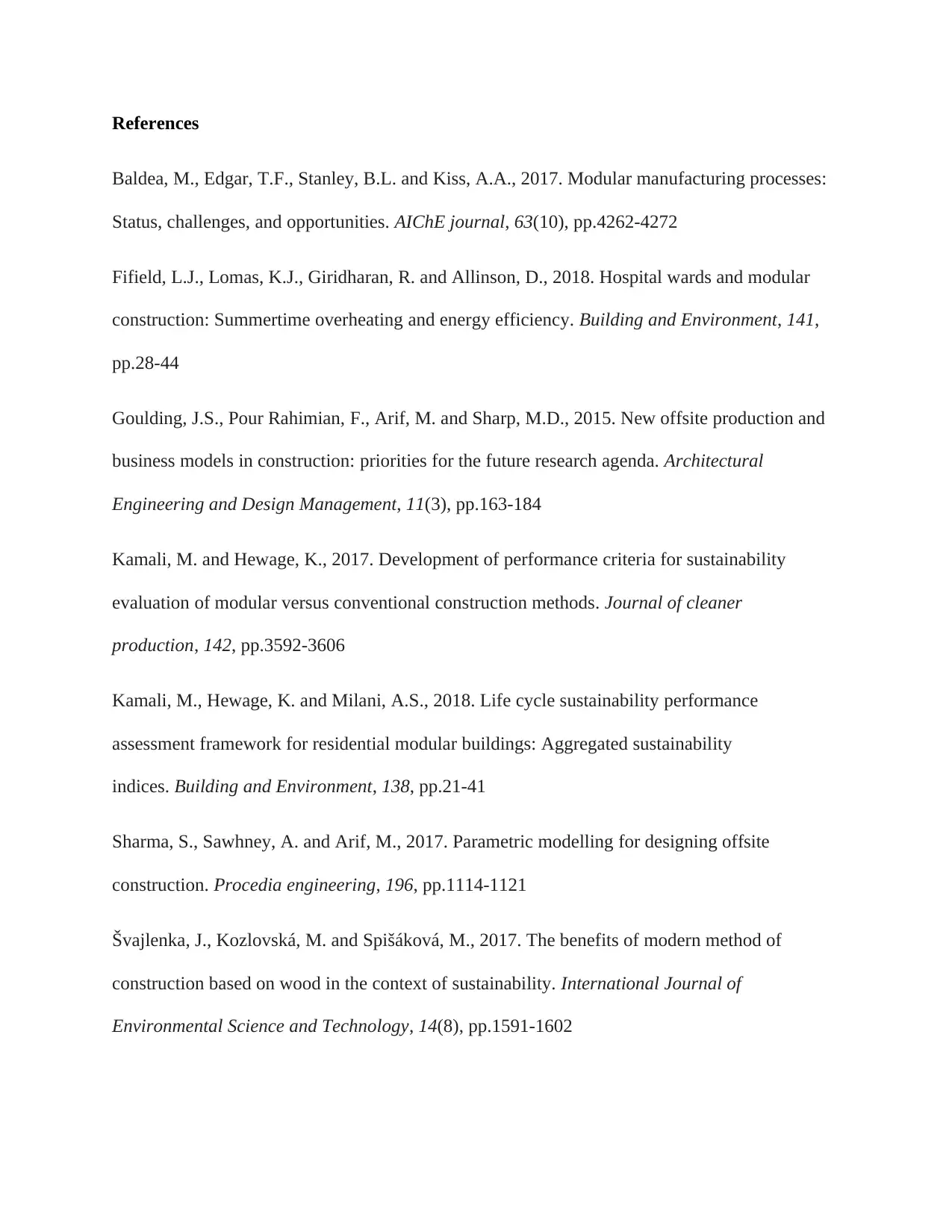
References
Baldea, M., Edgar, T.F., Stanley, B.L. and Kiss, A.A., 2017. Modular manufacturing processes:
Status, challenges, and opportunities. AIChE journal, 63(10), pp.4262-4272
Fifield, L.J., Lomas, K.J., Giridharan, R. and Allinson, D., 2018. Hospital wards and modular
construction: Summertime overheating and energy efficiency. Building and Environment, 141,
pp.28-44
Goulding, J.S., Pour Rahimian, F., Arif, M. and Sharp, M.D., 2015. New offsite production and
business models in construction: priorities for the future research agenda. Architectural
Engineering and Design Management, 11(3), pp.163-184
Kamali, M. and Hewage, K., 2017. Development of performance criteria for sustainability
evaluation of modular versus conventional construction methods. Journal of cleaner
production, 142, pp.3592-3606
Kamali, M., Hewage, K. and Milani, A.S., 2018. Life cycle sustainability performance
assessment framework for residential modular buildings: Aggregated sustainability
indices. Building and Environment, 138, pp.21-41
Sharma, S., Sawhney, A. and Arif, M., 2017. Parametric modelling for designing offsite
construction. Procedia engineering, 196, pp.1114-1121
Švajlenka, J., Kozlovská, M. and Spišáková, M., 2017. The benefits of modern method of
construction based on wood in the context of sustainability. International Journal of
Environmental Science and Technology, 14(8), pp.1591-1602
Baldea, M., Edgar, T.F., Stanley, B.L. and Kiss, A.A., 2017. Modular manufacturing processes:
Status, challenges, and opportunities. AIChE journal, 63(10), pp.4262-4272
Fifield, L.J., Lomas, K.J., Giridharan, R. and Allinson, D., 2018. Hospital wards and modular
construction: Summertime overheating and energy efficiency. Building and Environment, 141,
pp.28-44
Goulding, J.S., Pour Rahimian, F., Arif, M. and Sharp, M.D., 2015. New offsite production and
business models in construction: priorities for the future research agenda. Architectural
Engineering and Design Management, 11(3), pp.163-184
Kamali, M. and Hewage, K., 2017. Development of performance criteria for sustainability
evaluation of modular versus conventional construction methods. Journal of cleaner
production, 142, pp.3592-3606
Kamali, M., Hewage, K. and Milani, A.S., 2018. Life cycle sustainability performance
assessment framework for residential modular buildings: Aggregated sustainability
indices. Building and Environment, 138, pp.21-41
Sharma, S., Sawhney, A. and Arif, M., 2017. Parametric modelling for designing offsite
construction. Procedia engineering, 196, pp.1114-1121
Švajlenka, J., Kozlovská, M. and Spišáková, M., 2017. The benefits of modern method of
construction based on wood in the context of sustainability. International Journal of
Environmental Science and Technology, 14(8), pp.1591-1602
Paraphrase This Document
Need a fresh take? Get an instant paraphrase of this document with our AI Paraphraser
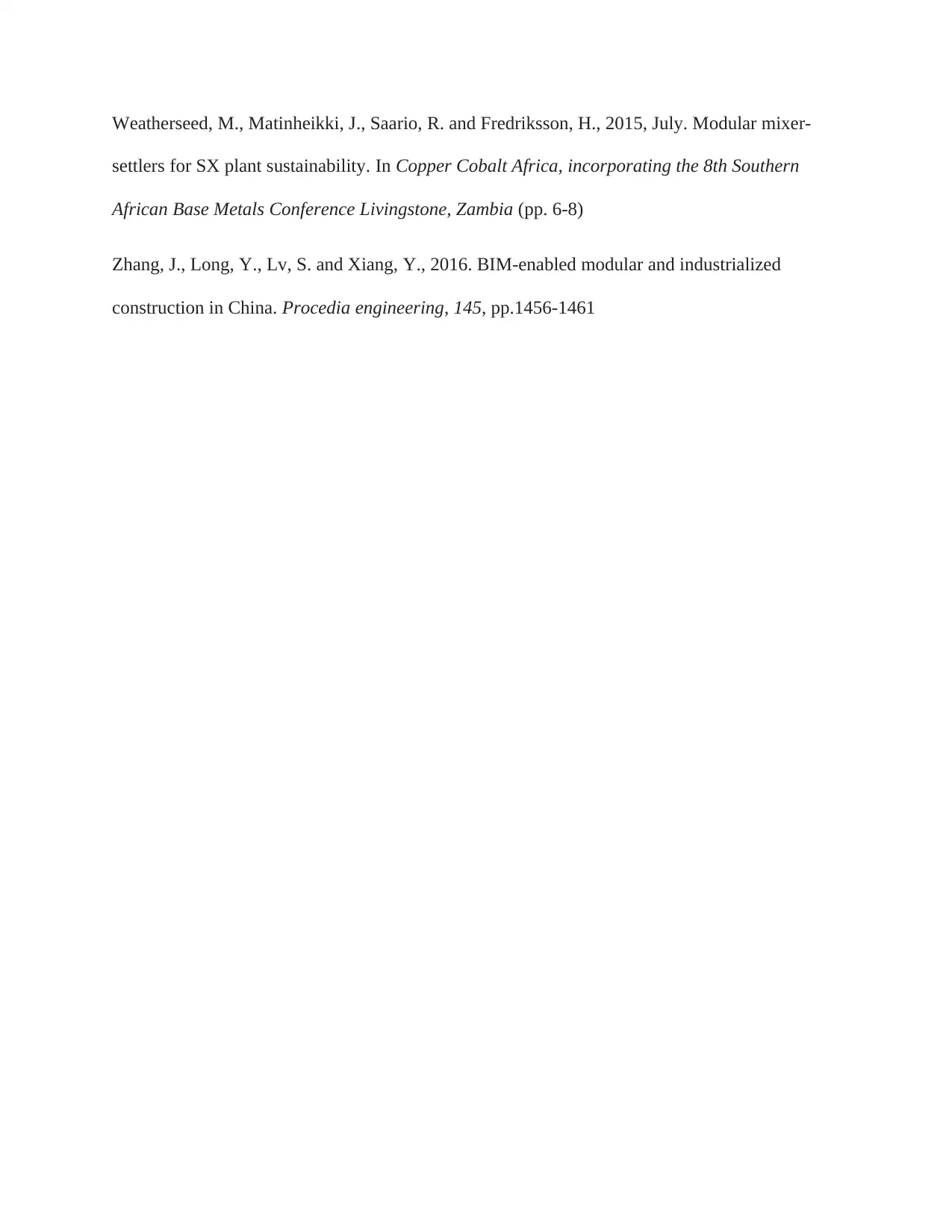
Weatherseed, M., Matinheikki, J., Saario, R. and Fredriksson, H., 2015, July. Modular mixer-
settlers for SX plant sustainability. In Copper Cobalt Africa, incorporating the 8th Southern
African Base Metals Conference Livingstone, Zambia (pp. 6-8)
Zhang, J., Long, Y., Lv, S. and Xiang, Y., 2016. BIM-enabled modular and industrialized
construction in China. Procedia engineering, 145, pp.1456-1461
settlers for SX plant sustainability. In Copper Cobalt Africa, incorporating the 8th Southern
African Base Metals Conference Livingstone, Zambia (pp. 6-8)
Zhang, J., Long, Y., Lv, S. and Xiang, Y., 2016. BIM-enabled modular and industrialized
construction in China. Procedia engineering, 145, pp.1456-1461
1 out of 8
Related Documents
Your All-in-One AI-Powered Toolkit for Academic Success.
+13062052269
info@desklib.com
Available 24*7 on WhatsApp / Email
![[object Object]](/_next/static/media/star-bottom.7253800d.svg)
Unlock your academic potential
Copyright © 2020–2025 A2Z Services. All Rights Reserved. Developed and managed by ZUCOL.





